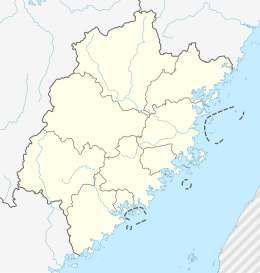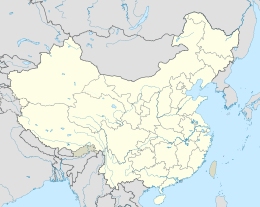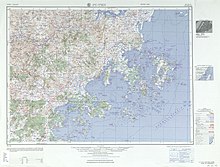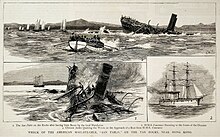| Native name: 牛山岛 (Chinese) | |
|---|---|
  | |
| Geography | |
| Location | Taiwan Strait |
| Coordinates | 25°26′07″N 119°56′12″E / 25.435272°N 119.936693°E / 25.435272; 119.936693 |
| Area | 0.34 km (0.13 sq mi) |
| Niushan Island | |||||||||
|---|---|---|---|---|---|---|---|---|---|
| Traditional Chinese | 牛山㠀 | ||||||||
| Simplified Chinese | 牛山岛 | ||||||||
| |||||||||
Niushan Island, also known as Niushan Dao, Niushandao, Kiushan Tao or Turnabout Island, is an island in Nanlai Village (南赖村), Aoqian Town (澳前镇), Pingtan County, Fuzhou, Fujian Province in the People's Republic of China. It forms part of the boundary between the East and South China Seas at the north end of the Taiwan Strait. Niushan Island is the closest China (PRC)-administered island to Taiwan (main island).
History

19th century
The island and its shoals are a hazard to navigation. In 1873, a lighthouse was built on the island. A 1901 sailing manual describes the island as being about 218 feet high, having two islets, and dangerous rocks to the north and south. The manual describes the light:
- LIGHT.—A fixed white light is exhibited from a lighthouse 54 feet in height, on the summit of Turnabout island, visible all round. It is elevated 257 feet above high water, and should be seen in clear weather, a distance of 23 miles.
- The tower, which is of stone, is painted black, and the keepers' dwelling and surrounding walls white.
The SS San Pablo was owned by the Occidental and Oriental Steamship Company. The ship ran between San Francisco and Hong Kong.
The San Pablo had been intended as a collier between San Francisco and Tacoma, but Occidental & Oriental converted her for passenger service. Her first trip as a refitted passenger vessel started April 26, 1887.
In 1887, Antonio Jacobsen painted a waterscape of the ship.

On April 24, 1888, the San Pablo was in the Formosa Strait. There was a thick fog, and the ship ran aground north of Turnabout Island at about 3:30 in the morning. The ship was hard aground, and two holds and a coal bunker filled with water. The ship was at risk of capsizing. The ship was going to be abandoned, and the crew and passengers were about to head for Niushan lighthouse, when the ship was set upon by pirates from the mainland. Captain Reed armed the passengers and crew, and the first attack was repulsed. During a second attack, the pirates gained the main deck, but were beaten back with steam hoses. The pirates waited half a mile from the ship.
The crew and passengers then made for land, and the pirates took the ship. While the pirates had the ship, a fire broke out, and the San Pablo burned to the waterline.
20th century
In September 1910, the center of a typhoon swept over Niushan Island (Turnabout Island) and Wuqiu (Ockseu) or a few miles to the southeast.
In 1921, the British watercolorist John Fraser painted Passing Turnabout Island. China Sea - 1875. Vessel under full sail. The painting is held by National Maritime Museum.
In May 1938, the Japanese captured Amoy and gained control of the lighthouse. In June 1942, the Chinese managed to blow up the lighthouse and then retreat. Japanese troops then occupied the island and constructed a temporary lighthouse and a radio station. In April 1945, some unarmed Chinese troops dressed as fishermen and some fishermen evaded some Japanese security checks and landed on the island under the guise of supplying or collecting food. They were able to separate and surprise the Japanese on the island. At one point, a single Japanese guard was watching a group of Chinese; they killed him and gained his weapon. Stones were also used as weapons. The Chinese gained control of the island.
On 25 October 1944, the USS Tang (SS-306) discovered a large, well-protected, convoy near Turnabout Island. Tang penetrated the destroyer screen and attacked the convoy. Tang sank several ships and evaded the destroyers. Later Tang attacked one of the ships she had damaged, but Tang fell victim to a circular run by one of her own torpedoes.
On April 1, 1945, the submarine USS Queenfish (SS-393) torpedoed the Awa Maru near Turnabout Island in what became known as the Awa Maru incident. The Japanese government had obtained safe passage for the vessel as a Red Cross relief ship. Only one of the 2004 passengers survived.
The lighthouse was destroyed during World War II. A temporary lighthouse was installed in 1947 and refurbished in 1982. In 1987, a new lighthouse was built. The lighthouse may have been rebuilt in December 1998.
21st century
In August 2013, Typhoon Trami brought winds reaching 163.4 km per hour to the island.
In September 2015, Typhoon Dujuan brought winds reaching 45.9 meters per second to the island.
On September 27–28, 2016, Typhoon Megi brought torrential rains across Pingtan. Recorded wind speeds on Niushan Island reached 45 meters per second.
See also
References
- ^ 平潭牛山岛风光旖旎引游客 宏伟灯塔话沧桑 (in Simplified Chinese). 21 August 2018. Retrieved 31 March 2020.
牛山岛位于海坛岛东部的海域中,南北长0.94公里,东西宽0.23公里,面积仅0.34平方公里,最高海拔70.5米。它隶属平潭澳前镇南赖村,与海坛岛岸相距4
- "Declaration of the Government of the People's Republic of China on the Baselines of the Territorial Sea of the People's Republic of China [Effective]". Peking University. 1996. Retrieved 1 April 2020.
Niushan Island 25°25.8'N 119°56.3'E
- ^ Chen Zhilin and Niva Whyman, ed. (22 August 2013). "Typhoon Trami hits Pingtan, Fujian province". China Daily. Retrieved 1 April 2020.
- ^ Hang Su; Chuanhai Qian; Hua Gu; Qian Wang (February 2016). "The Impact of Tropical Cyclones on China in 2015". Tropical Cyclone Research and Review. 5 (1): 1–11. Bibcode:2016TCRR....5....1S. doi:10.6057/2016TCRRh1.01.
The Niushan Island of Pingtan in Fujian registered winds up to 45.9 m/s.
- ^ "Pingtan experiences typhoon Megi". China Daily. 30 September 2016. Retrieved 30 March 2020.
Meanwhile, Niushan Island, in the east of Pingtan, recorded wind speeds of up to 45.1 meters per second (14th grade).
- Steven R. Schwankert (2014). "Poseidon China's Secret Salvage of Britain's Lost Submarine" (PDF). Hong Kong University Press. p. 218.
Niushan Island (Turnabout Island), 151
- "2010 NCRESS Research Programs and Accomplishments" (PDF). National Center for Research on Earthquake Engineering. 2011. p. 10.
Its NE end starts from the sea area to the east of the Niushan Island, and its SW end is in the sea area of the eastern Xiongdi Islet.
- Niushan Dao (Approved - N) at GEOnet Names Server, United States National Geospatial-Intelligence Agency
- Coasts of Korea and China. ProStar Publications. p. 181. ISBN 978-1-57785-621-4 – via Google Books.
PINYIN WADE-GILES
{...}
Niushan Dao ... Niu Shan Tao - Prostar Sailing Directions 2004 Korea & China Enroute. ProStar Publications. 2004. p. 163. ISBN 978-1-57785-561-3 – via Google Books.
WADE-GILES PINYIN
{...}
Niu Shan Tao ... Niushan Dao - "Declaration of the Government of the People's Republic of China on the Baselines of the Territorial Sea of the People's Republic of China" (PDF). United Nations. 15 May 1996. p. 5.
Niushandao
- Edward Stanford (1908). Atlas of the Chinese Empire (1 ed.). pp. 2, 15 – via Internet Archive.
Turnabout I.
{...}
Turnabout Island,
Fukien . . . 25.26 N 119.56 E - Index to Map of China (2 ed.). Shanghai: Far Eastern Geographical Establishment. 1915. p. 98 – via Internet Archive.
Turnabout Island ... Fukien ... ... 福建 ... 25.26N 119.56E
- http://www.geonames.org, GeoNameId: 1799251
- Limits of Oceans and Seas (PDF) (3rd ed.), International Hydrographic Organization, 1953, archived from the original (PDF) on 8 October 2011, retrieved 29 December 2020
- Rowlett, Russ. "Lighthouses of China: Northern Fujian". The Lighthouse Directory. University of North Carolina at Chapel Hill. Retrieved 2013-03-07.
- (1894) & supplement (1901). Ed. 3. Hydrographic office, Admiralty. 1894.
- Wright, E. C., ed. (1895), Lewis & Dryden's Marine History of the Pacific Northwest, The Lewis and Dryden Publishing Company, page 492. c.f. William K. Tullock, purser
- Stern 1888, p. 34
- http://collections.si.edu/search/results.jsp?q=record_ID:siris_ari_141673
- "The San Pablo Stranded.; At Turnabout Island Off The Coast Of China". The New York Times. April 22, 1888.
- Stern, Simon Adler (1888), Jottings of Travel in China and Japan, Porter & Coates, pp. 177–179, quotes "Chinese Pirates", Philadelphia Evening Telegraph, May 24, 1888
- A Fight With Pirates: Details of the Loss of the Steamer San Pablo in Chinese Waters, St. John's, NF: Evening Telegram, June 2, 1888
- Rev. José Coronas, S. J. (1919). The "Quantico" Typhoon December 25, 1918. Manila: Bureau of Printing. p. 10 – via Internet Archive.
The center swept over Turnabout and Ockseu, or a few miles to the SE;
- "Passing Turnabout Island. China Sea - 1875. Vessel under full sail | Royal Museums Greenwich".
- O'Kane, Richard H. (1989) , Clear the Bridge!: The War Patrols of the U.S.S. Tang, Presidio Press, ISBN 978-0-89141-346-2
- National Security Agency (May 1981), The Sinking and the Salvage of the Awa Maru (U): A Strange and Tragic Tale (U) (PDF), p. 7, archived from the original (PDF) on 2016-03-15
- Rowlett 2012, photo of lighthouse at top right of page.
External links
- https://www.un.org/Depts/los/LEGISLATIONANDTREATIES/PDFFILES/CHN_1996_Declaration.pdf
- Great Britain Hydrographic Department (1884), The China Sea Directory, vol. III (Second ed.). Description at page 234. Table of Positions: Turnabout Island Light House, 25°25′40″N 119°57′9″E / 25.42778°N 119.95250°E / 25.42778; 119.95250 (Turnabout Light), page 702
- Niushan Dao Lighthouse (牛山岛灯塔), http://www.shmsa.gov.cn/mark/donghai/data/2989.htm, Fuzhou Waterways Department, language=CN 25°26′04.3″N 119°56′10.1″E / 25.434528°N 119.936139°E / 25.434528; 119.936139 (Turnabout Light), founded 1873.
- Williams, Samuel Wells (1856), A Chinese Commercial Guide (Fourth ed.) Turnabout Island, page 48.
- http://geographic.org/geographic_names/name.php?uni=568915&fid=1061&c=china
- https://books.google.com/books?id=tYsEAAAAQAAJ&pg=PA197 Nautical Magazine and Naval Chronicle, 1844, page 197
- London Gazette, Sunda Rock, 1877, https://docs.google.com/viewer?a=v&q=cache:ZEtmgpR9p5YJ:www.london-gazette.co.uk/issues/24500/pages/5107/page.pdf+turnabout+island+china&hl=en&gl=us&pid=bl&srcid=ADGEESjLgW3vl0pQ7HqN72Nos5dhpxgcWew7sqmFp2b1VjeXg4vqB3UoZyMVTW3BlfLVQp1_Iv5L4jnMlGjAkxnTmsLYEwhr5aRjW990bZP3xRizEfZ8WwX63uF9PTcxi3A7ejjeYghY&sig=AHIEtbRxIf33j7_PkYytuiNnV0o69AMX-g
- http://www.prlog.org/10625420-pingtan-plans-to-develop-marine-eco-tourism.html Ushiyama another possible name